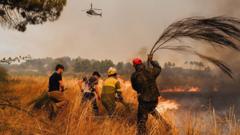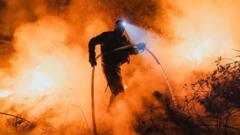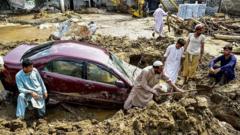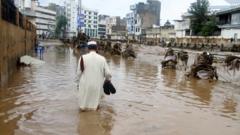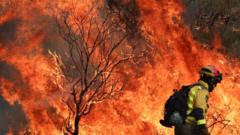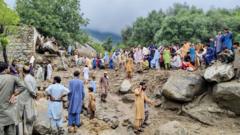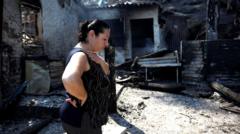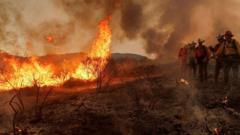As climate change continues to amplify heatwave frequency and intensity, the WHO warns that millions of workers, especially those in sectors like construction and agriculture, face significant health risks from extreme heat.
WHO Highlights Workplace Heat Risks Amid Climate Change Crisis
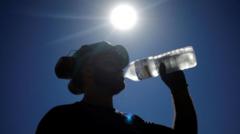
WHO Highlights Workplace Heat Risks Amid Climate Change Crisis
In a recent report, the World Health Organization emphasizes the growing threat of extreme heat in workplaces globally, urging better protective measures for workers.
The article text:
The World Health Organization (WHO) has sounded the alarm about the increasing risks posed by extreme heat in the workplace, a concern amplified by climate change. This warning comes as part of a new report co-authored with the World Meteorological Organization (WMO), presenting evidence that millions of workers are susceptible to heat stress, which can adversely affect both their health and productivity.
This report marks the first formal statement from the WHO on work-related heat stress since 1969, highlighting an urgent need for protective measures. Rüdiger Krech, the WHO's director of environment, climate, and health, calls the findings a crucial wake-up call, asserting that the impact of extreme heat transcends mere discomfort, posing serious health risks such as heat-related stress, strokes, kidney failure, and dehydration.
The report underscores the facts that heatwaves are no longer isolated events; the last decade has registered unprecedented temperature rises, with 2024 anticipated to be one of the hottest years on record. In various European regions, temperatures surpassing 40°C (104°F) are becoming commonplace, while certain areas in Africa and the Middle East experience peaks nearing 50°C. The global average for Mediterranean surface temperatures during July reached a record high this year, further illustrating the trend of intense summer heat.
The implications extend beyond health. The WHO indicates a direct correlation between rising temperatures and declining productivity, noting a 2% drop for every degree Celsius increase above 20°C. Increased workplace accidents are also associated with extreme heat; for example, when Swiss temperatures exceeded 30°C in 2023, incidents surged by 7%, attributed to compromised worker focus and sleep deprivation.
In response, some European nations are implementing adaptive strategies to safeguard workers during peak heat periods. Italy's government recently enacted an emergency decree, collaborating with labor unions and employers to curb labor during the hottest hours. Meanwhile, in Switzerland, construction activities were halted during this year's heatwave, an initiative endorsed by the nation's largest trade union, Unia. Union representative Nico Lutz stresses the importance of prioritizing worker safety over deadlines, urging construction firms to acknowledge the dangers of working under extreme heat conditions.
Beyond workplaces, vulnerable populations, including the elderly, chronically ill, and children, are also at high risk during heat events. Notably, German schools had historical policies to declare "Hitzefrei" when temperatures crossed certain thresholds, enabling students to leave early. However, the escalating frequency of high temperatures has made such interruptions challenging. Rüdiger Krech recognizes the hesitance regarding the educational disruptions seen during the COVID-19 pandemic, advocating for environmentally sound adaptations in schools and workplaces alike.
In states like Switzerland, experiencing heatwaves with temperatures surpassing 30°C upon the resumption of schools, educators have been advised to relocate classes to swimming facilities when possible. Yet, educators like Dagmar Rösler, head of the Swiss teachers' association, emphasize the impracticality of conducting all lessons in such settings. She advocates for investments in school infrastructure, including improved ventilation and air-conditioning systems, to foster conducive learning conditions.
The WHO/WMO report encourages inclusive discussions among governments, employee representatives, and health and education sectors to formulate effective adaptation strategies. Krech also raises pertinent questions about the suitability of school uniforms in the context of rising temperatures, suggesting that this is an aspect worth considering for student comfort.
While adapting infrastructure to meet the challenges of excessive heat necessitates significant investment, Krech cautions against overlooking these needs as other spending priorities, particularly defense, take precedence in some regions. He highlights the potential long-term costs associated with neglecting heat adaptation, urging decision-makers to weigh the economic implications of a workforce compromised by extreme heat against the upfront investment in protective measures.
In summary, the WHO’s findings serve as a clarion call for immediate action to protect workers and vulnerable populations from the escalating impacts of climate change and extreme heat, ensuring that safety and productivity can coexist in an era marked by rising temperatures.
The World Health Organization (WHO) has sounded the alarm about the increasing risks posed by extreme heat in the workplace, a concern amplified by climate change. This warning comes as part of a new report co-authored with the World Meteorological Organization (WMO), presenting evidence that millions of workers are susceptible to heat stress, which can adversely affect both their health and productivity.
This report marks the first formal statement from the WHO on work-related heat stress since 1969, highlighting an urgent need for protective measures. Rüdiger Krech, the WHO's director of environment, climate, and health, calls the findings a crucial wake-up call, asserting that the impact of extreme heat transcends mere discomfort, posing serious health risks such as heat-related stress, strokes, kidney failure, and dehydration.
The report underscores the facts that heatwaves are no longer isolated events; the last decade has registered unprecedented temperature rises, with 2024 anticipated to be one of the hottest years on record. In various European regions, temperatures surpassing 40°C (104°F) are becoming commonplace, while certain areas in Africa and the Middle East experience peaks nearing 50°C. The global average for Mediterranean surface temperatures during July reached a record high this year, further illustrating the trend of intense summer heat.
The implications extend beyond health. The WHO indicates a direct correlation between rising temperatures and declining productivity, noting a 2% drop for every degree Celsius increase above 20°C. Increased workplace accidents are also associated with extreme heat; for example, when Swiss temperatures exceeded 30°C in 2023, incidents surged by 7%, attributed to compromised worker focus and sleep deprivation.
In response, some European nations are implementing adaptive strategies to safeguard workers during peak heat periods. Italy's government recently enacted an emergency decree, collaborating with labor unions and employers to curb labor during the hottest hours. Meanwhile, in Switzerland, construction activities were halted during this year's heatwave, an initiative endorsed by the nation's largest trade union, Unia. Union representative Nico Lutz stresses the importance of prioritizing worker safety over deadlines, urging construction firms to acknowledge the dangers of working under extreme heat conditions.
Beyond workplaces, vulnerable populations, including the elderly, chronically ill, and children, are also at high risk during heat events. Notably, German schools had historical policies to declare "Hitzefrei" when temperatures crossed certain thresholds, enabling students to leave early. However, the escalating frequency of high temperatures has made such interruptions challenging. Rüdiger Krech recognizes the hesitance regarding the educational disruptions seen during the COVID-19 pandemic, advocating for environmentally sound adaptations in schools and workplaces alike.
In states like Switzerland, experiencing heatwaves with temperatures surpassing 30°C upon the resumption of schools, educators have been advised to relocate classes to swimming facilities when possible. Yet, educators like Dagmar Rösler, head of the Swiss teachers' association, emphasize the impracticality of conducting all lessons in such settings. She advocates for investments in school infrastructure, including improved ventilation and air-conditioning systems, to foster conducive learning conditions.
The WHO/WMO report encourages inclusive discussions among governments, employee representatives, and health and education sectors to formulate effective adaptation strategies. Krech also raises pertinent questions about the suitability of school uniforms in the context of rising temperatures, suggesting that this is an aspect worth considering for student comfort.
While adapting infrastructure to meet the challenges of excessive heat necessitates significant investment, Krech cautions against overlooking these needs as other spending priorities, particularly defense, take precedence in some regions. He highlights the potential long-term costs associated with neglecting heat adaptation, urging decision-makers to weigh the economic implications of a workforce compromised by extreme heat against the upfront investment in protective measures.
In summary, the WHO’s findings serve as a clarion call for immediate action to protect workers and vulnerable populations from the escalating impacts of climate change and extreme heat, ensuring that safety and productivity can coexist in an era marked by rising temperatures.

